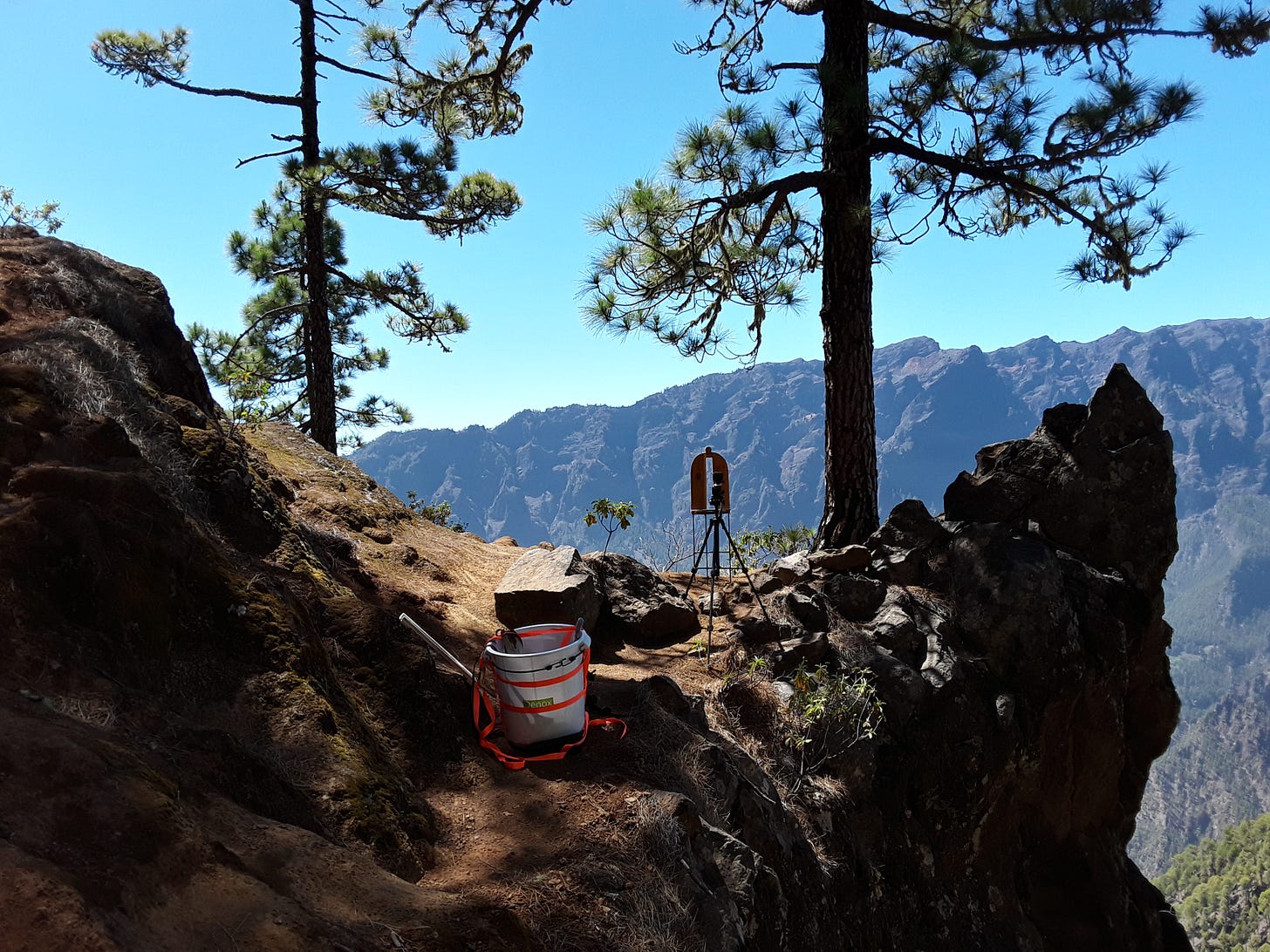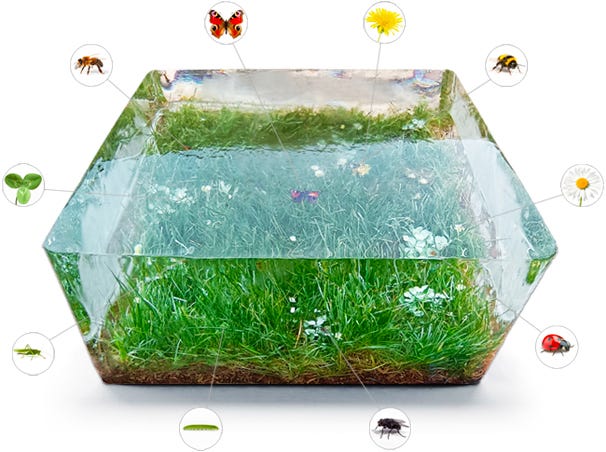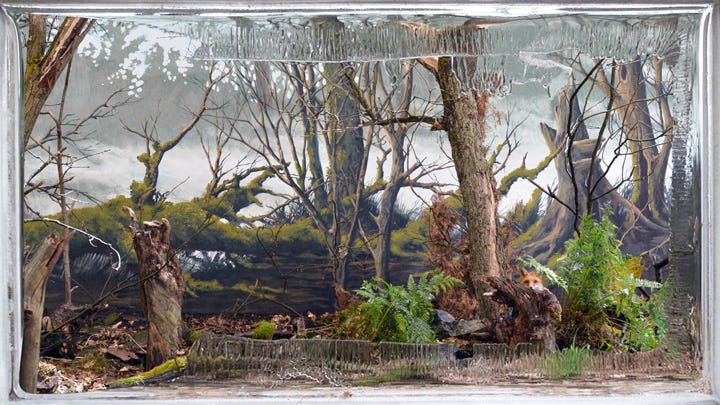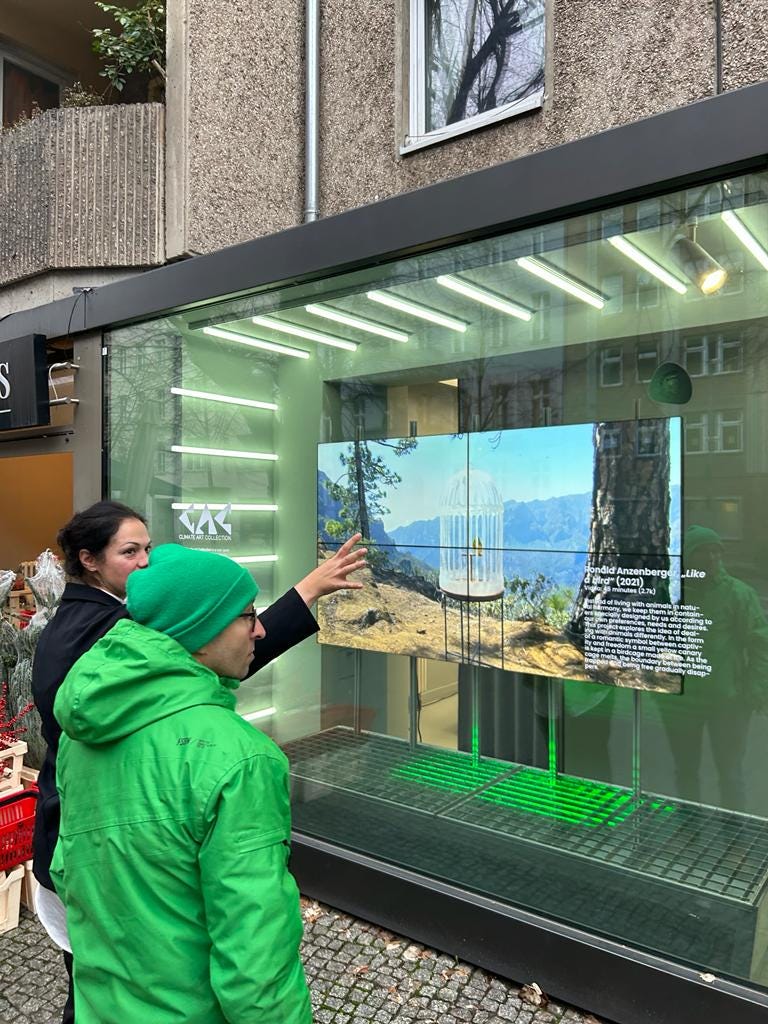Ronald Anzenberger, a member of the Climate Art Collection, a conceptual artist, and an ice sculptor, is currently showcasing his film "Like a bird" at the conFRONTation exhibition, a storefront exhibition in Berlin Mitte. He answered some of our questions from his -14 degrees Celsius cold workplace in Hamburg - Our conversation revolved around climate change, the utilization of ice as a sculpting material, and the creation process behind “Like a bird”.
CAC: What is your climate change story? When did you become aware that climate change is a socially relevant issue - perhaps even a threat to society?
Ronald: Regarding my work as a sculptor, I would say there is a particular project that has significantly impacted me in relation to climate change. Some years ago, I had the opportunity to be involved in a project aimed at designing the Polarium for the Rostock Zoo. Specifically, the task was to cover the facility for penguins and polar bears with artificial rocks and create wall paintings. During the conceptual development, the idea emerged to portray the landscape without ice and snow - a great approach to raise awareness among the audience about the disappearance of ice and the changing habitat of animals such as penguins or polar bears.
At the same time, it was during this phase that I was already working with ice - I create art from ice, which is a habitat for other living beings. Witnessing the decline or disappearance of this habitat has certainly had a profound and lasting impact on me.
CAC: You grew up in Austria and attended a school for wood and stone sculpture located in the mountains - the Higher Technical Federal Institute Hallstatt - did this influence your relationship with nature?
Ronald: My connection to nature comes from my grandfather, who, together with my father before my birth, built a small wooden cabin in the middle of the forest. I spent my childhood there - as children, we could play in the woods or observe animals by the river that ran right next to it. Over the years, I was also able to perceive the loss of biodiversity there. I believe that's where my connection to nature comes from.
What influenced me at the HTBLA, the specialized school for sculpture, was the understanding of nature and its materials, such as wood and stone - understanding that trees have annual rings, that wood has grain, and that stones possess a certain structure by which they can be naturally broken and worked. The focus was more on the material itself rather than on nature as a whole. The theme of nature emerged later in my work.
CAC: When did the environment or specifically climate change become a theme in your art?
Ronald: The nature or our environment only became a theme in my art during my art studies - it was after attending the HTBLA, where the focus was primarily on working with materials. During my studies, the focus quickly shifted towards understanding and perceiving materials. It also involved presenting artworks and how they are interpreted by the viewer. Additionally, exploring how themes can be encapsulated in art. It was only then that nature, or rather our environment, gradually came into focus.
I remember that during my studies, I was particularly intrigued by the comparison between nature, that what is untouched by humans, and art, that what is created by humans. In my thesis, for instance, the aim was to illustrate human influence within nature through art – incidentally, this was also a project involving ice.
CAC: We are currently exhibiting your artwork 'Like a bird.' Could you describe how you created this artwork - from the initial thought to the finished video?
Ronald: I can't exactly recall when I had the idea for this project. It must have been about ten years ago. The firm decision to realize this project was made in autumn 2018, when I was still in my studio in Berlin. I built two prototypes: the first one was more of an attempt, but the second one turned out not too bad - although during the second attempt, a bar of the cage broke off, which wasn't too severe in the studio as it could be easily repaired there, but could be quite frustrating in nature. Nevertheless, I had enough confidence that it would work out on the third attempt.
The next step was deciding which animal to focus on. Since for me, the canary bird symbolizes songbirds in captivity, it was relatively clear that I would go to Spain, as I needed the natural habitat of the animal. So, in the spring of 2019, I flew to the Canary Island La Palma to realize the project.
I had allocated three weeks for the realization. The first week involved organizational matters, such as finding the filming location, setting up a workspace, and arranging for a freezer - which was quite challenging on the small island. The second week was primarily dedicated to the production of the ice cage, and in the third week, we conducted test shots and filmed the video.
In retrospect, the final day of shooting was the most exhausting day in my professional career as a sculptor, as it involved transporting all the equipment into the mountains, into the Caldera de Taburiente National Park at an altitude of 1200 meters. We were able to cover the first 900 meters in altitude up to the visitor parking lot by car, but we had to hike the last 300 meters in altitude.
I had to hike twice. Once to carry the equipment uphill, to set up the filming location, and to pre-align the camera, as the ice melts very quickly in the summer temperatures. The second time, I had to carry the ice cage with a self-made backpack. Since I knew the backpack would be heavy, I hadn't weighed it beforehand or tested it - then I probably would have chosen a different filming location.
However, I went up a second time, and upon reaching the top, totally exhausted and almost out of strength, I assembled the cage with steady hands and filmed the piece that you can see today in the 'conFRONTation' exhibition.
CAC: Are you a political artist - an 'artivist'?
Ronald: I wouldn't label myself as an activist, especially since I often don't endorse the strategies or methods employed by animal and environmental protection organizations. For me, they represent the wrong strategies. Nevertheless, in conceptual art, the primary goal is to experience the work intellectually. As I attempt to facilitate targeted changes in perspective on predetermined subjects through my work, it does serve an activist function - yet, I wouldn't identify myself as an activist.
CAC: What fascinates you about the material ice?
Ronald: Besides the fact that ice is a highly versatile material - you can carve a sculpture from a finished ice block or cast ice, and in its pure form, it is entirely transparent, allowing objects to freeze within it - what primarily fascinates me is its transience.
In the beginning, when I started working with ice, it was somewhat challenging. Unlike static sculptures or objects that you set up and maybe rearrange, with ice, you need to plan the presentation very precisely in advance and also consider what happens afterward - how will the meltwater be collected. The entire technique and logistics are somewhat different.
Over the years, I've learned to consciously integrate the melting process into my work. Especially with the installations I do today, it's not so much about the ice itself anymore, but rather about the situation before and after the melting process. This means the works are only complete when the ice has completely melted.
CAC: Do you believe that art should inherently be created sustainably? Why or why not?
Ronald: Yes, but I find it challenging to confine sustainability to one area. Like any other business, as an artist, one should naturally consider where to source materials or where to produce. Certainly, I also have to ask myself questions about where I source my energy or what machines I use to produce ice. There's a certain energy input required. Since I primarily work only with water and partly use rainwater – it feels right to me in terms of sustainability.
However, I must say, specifically concerning art - I have more tolerance for less sustainable art compared to other things, especially when the art, even if not sustainably produced, addresses sustainability. If it raises awareness among gallery visitors on this issue, it can still be a fantastic thing and achieve a certain success in that regard.
CAC: Have you experienced that your art has an impact on the people who see it? How do viewers, for example, react to artworks made of ice?
Ronald: My experience with exhibiting artworks made of ice is that ice has a very fascinating effect on its audience. Especially when paired with light, ice sparkles and shines incredibly beautifully. Ice is cold, it's temporary - made just for a brief moment when it can be perceived - then it's gone.
In this sense, ice is already very, very dominant. Even in galleries, I've found that often you'd need to put up a construction fence around the artwork to prevent visitors from touching the ice sculptures or even children from licking them.
Regarding my films, where the melting process is usually shown in real-time, without editing or time-lapse, I consistently notice that people really take their time with my work. They sit down and observe the artwork. Because that's the only way thoughts and processes develop in their minds. To evoke that in visitors, in a time when many things have become so fast-paced and fleeting, is a small success for me - it genuinely delights me.
CAC: We got to know you at one of your exhibitions. What fascinated you about CAC - why did you become part of the team?
Ronald: First of all, thank you very much for following my invitation and for us having the chance to meet at one of my exhibitions. It was a very pleasant first encounter. So, thank you once again for that.
What fascinated me about the Climate Art Collection from the beginning was its potential. Art is, in a way, like a language, and people speak different languages. Additionally, each person has different desires, preferences, and emotions, and they are emotionally reachable in different ways. Since the Climate Art Collection ultimately pursues the same goal as I do with my ice art - to sensitize as many people as possible to climate change, and since I cannot emotionally reach all people with my artworks alone, having access to such a wide range of artists and media to emotionally touch as many people as possible on the topic of climate change is tremendous.
If I can contribute in any way in terms of curation or with any other questions regarding exhibitions in this regard, then I am more than happy to do so.
CAC: Beyond individual efforts, what do you think needs to happen on a political level to stop climate change?
Ronald: Oh, that's a good question. Especially because I am involved in art and not in politics. But one task in politics could be to make sustainability more economically rewarding. It cannot be that large companies that consume enormous amounts of energy are subsidized, while small companies trying to be as sustainable as possible do not receive financial support.
Stopping climate change on a political level seems challenging to me. Especially since politicians operate within limited boundaries on a country level and climate change is a global issue. What I appreciate about art, in turn, is that art transcends national borders and is quickly visible worldwide, especially through the internet. I believe that art, albeit in a different way, has at least as much, if not more, potential to counteract climate change than politics.
VISIT THE ARTWORK AT conFRONTation (Torstraße 207, 10115 Berlin)
conFRONTation is an avant-garde exhibition format in Berlin that critically addresses climate change within the unique context of storefront displays. These storefront often overlooked in the daily hustle and bustle by the general populace, mirrors the frequent disregard of pressing climate issues. This exhibit challenges the passive stance of the public by showcasing interdisciplinary artworks dealing with climate change, urging individuals to pause and deeply engage with the subject










